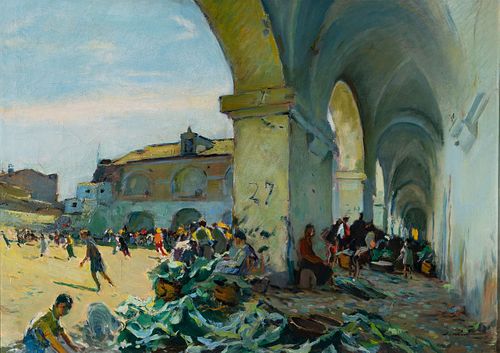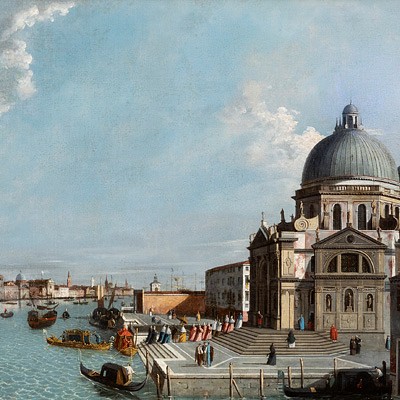JOAQUIM MIR TRINXET (Barcelona, 1873 - 1940). "Plaça del mercat de Vilanova". Oil on canvas. Relined. New frame. Signed in the lower right corner
Lot 44
About Seller
Setdart Auction House
Carrer Aragó 346
Barcelona
Spain
Setdart Subastas was born in 2004 and is currently the first online art auction in Spain with solidity, prestige and reliability guaranteed by our more than 60,000 users. Setdart has a young, dynamic and enterprising team ready to successfully manage the purchase and sale of art works through custom...Read more
Estimate:
EUR€25,000 - EUR€30,000
$26,881.72 - $32,258.06
Absentee vs Live bid
Two ways to bid:
- Leave a max absentee bid and the platform will bid on your behalf up to your maximum bid during the live auction.
- Bid live during the auction and your bids will be submitted real-time to the auctioneer.
Bid Increments
| Price | Bid Increment |
|---|---|
| EUR€0 | EUR€10 |
| EUR€200 | EUR€25 |
| EUR€500 | EUR€50 |
| EUR€1,000 | EUR€100 |
| EUR€3,000 | EUR€200 |
| EUR€5,000 | EUR€500 |
| EUR€10,000 | EUR€1,000 |
| EUR€20,000 | EUR€2,000 |
| EUR€50,000 | EUR€5,000 |
About Auction
By Setdart Auction House
May 18, 2021
Set Reminder
2021-05-18 09:30:00
2021-05-18 09:30:00
America/New_York
Bidsquare
Bidsquare : Classics XIX and XX
https://www.bidsquare.com/auctions/setdart-auction-house/classics-xix-and-xx-6961
The next 18th May there will be a 19th and 20th Century Classics Auction at Setdart.com There will be a select repertoire of important artists such as Carlos Cruz Diez, Luis Feito, Joan Miró, Fernando Botero, Josep Llimona, Salvador Dalí among others. Setdart Auction House sofia@setdart.com
The next 18th May there will be a 19th and 20th Century Classics Auction at Setdart.com There will be a select repertoire of important artists such as Carlos Cruz Diez, Luis Feito, Joan Miró, Fernando Botero, Josep Llimona, Salvador Dalí among others. Setdart Auction House sofia@setdart.com
- Lot Description
JOAQUIM MIR TRINXET (Barcelona, 1873 - 1940). "Plaça del mercat de Vilanova". Oil on canvas. Relined. New frame. Signed in the lower right corner and on the back. Measurements: 65 x 91 cm; 80 x 107 cm (frame). This is a characteristic work of Joaquim Mir, in his bold and joyful interpretation of the daily hustle and bustle in the atrium of a village market. Mir reduces reality to its basic elements through an excellent handling of light and color, suggesting the pulse that beats beneath the forms. Thus, the figures of the greengrocers and passers-by are pure chromatic agitation and the midday light seeps even into the shady nooks and crannies of the arcades. Joaquim Mir studied at the School of Fine Arts of San Jordi in Barcelona and in the workshop of the painter Luis Graner. He soon felt uncomfortable with the official teaching, anchored in a conception of realist painting, so in 1893 he founded with other colleagues the "Colla del Safrà", to investigate together in the pictorial initiatives of the end of the century. In 1896 they even participated as a group in the III Exhibition of Fine Arts and Artistic Industries, to which Mir presented two works: "La huerta del rector" and "El vendedor de naranjas". Also, since 1897 he frequented the artistic environment of "Els Quatre Gats", which helped him to mature in the compositional study of landscapes with figures in different planes of depth. During these years he took part in the Fine Arts Exhibitions of Barcelona, in their editions of 1894, 1896 and 1898. Winner of a second medal at the Madrid Exhibition of 1899, that same year he moved to the capital in order to compete for a scholarship in Rome. When he was unsuccessful, he went with Santiago Rusiñol to Mallorca, on a trip that would be a definitive turning point in his career. Mir was dazzled by the Mallorcan landscape, which was an inexhaustible source of inspiration for him. From then on, the artist deployed a whole combination of impossible colors, the result of his personal interpretation of the majestic nature of the island. The brushstrokes became longer and became stains that almost made objects and spatial references disappear. In 1901 he exhibited the fruit of this first Mallorcan stage individually at the Sala Parés in Barcelona, and again obtained a second medal at the National Exhibition. In 1907 he obtained the first medal at the International Exhibition of Fine Arts in Barcelona. Since then, installed in Camp de Tarragona, he will not move from the landscape genre, but now the surrounding villages will be the protagonists of his painting. In 1917, when he was awarded the National Prize of Fine Arts, he received the definitive national recognition. In 1929 he won the first medal at the International Exhibition in Barcelona. The following year he won the medal of honor at the National Exhibition in Madrid, an award he had been pursuing since 1922. Although he was mainly a native painter, he had solo and group exhibitions in Washington, Paris, Pittsburg, New York, Philadelphia, Amsterdam, Buenos Aires and Venice. Mir is today considered the most outstanding representative of Spanish post-impressionist landscape painting. His work is preserved in the National Art Museum of Catalonia, the Prado Museum, the Thyssen-Bornemisza Museum and the Reina Sofia Museum in Madrid, among many others.
- Shipping Info
-
In-House Shipping
-
- Buyer's Premium



 EUR
EUR CAD
CAD AUD
AUD GBP
GBP MXN
MXN HKD
HKD CNY
CNY MYR
MYR SEK
SEK SGD
SGD CHF
CHF THB
THB















